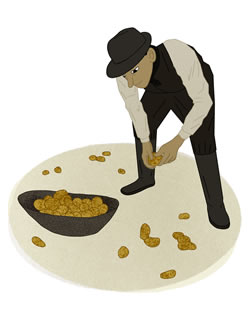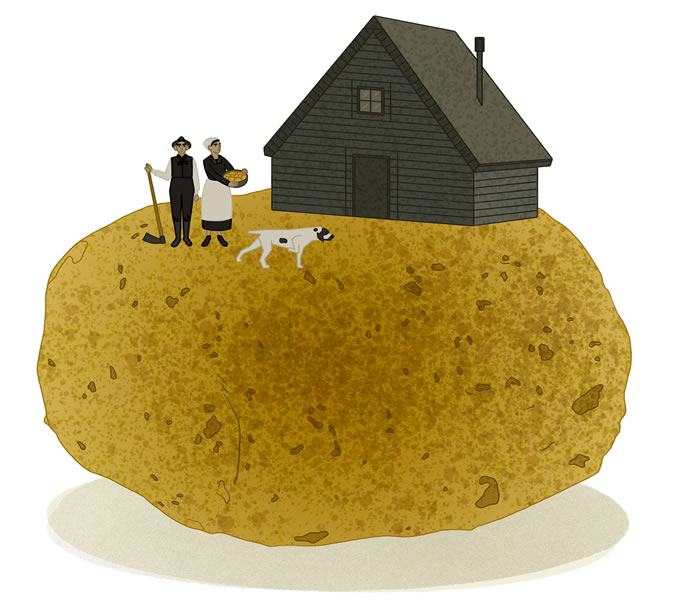 llustrations by Lisa Röper
llustrations by Lisa RöperIn the 16th century, the potato arrived in Europe.
The consequences went far beyond diet.
The potato, small and humble though it may be, has played an outsized role in history. Many scholars credit the hardy and nu-trient-rich crop with rapid population growth across Europe and the rise of industrialization and empires in the West.
Now the potato can add a new line to its already fascinating resume: peacemaker.
Research from Nancy Qian, a professor of managerial eco-nomics and decision sciences at the Kellogg School, finds that potatoes, and the permanent boost in agricultural productivi-ty they brought about, reduced armed conflict in the 18th and 19th centuries.
Qian and her two coauthors examined battles in Europe, North Africa and the Middle East between 1400 and 1900 – a notori-ously bloody and brutal period. “Everyone was fighting every-one, all the time,” she says.
But things changed when Spanish explorers brought back the potato from South America in the 16th century, her study shows. Suddenly, a family of four could grow enough food to survive on about a third as much land as they needed before. This abrupt change in the food supply prompted battle-hardened Europeans to put down their weapons.
Qian cannot say for sure exactly why people swapped the sword for the spud, but she has a strong suspicion.
“Although we talk about brand perceptions
specifically in this paper, the general idea of
looking to your users’ network connections
can be applied a lot of different ways.”
In a 2011 paper, Qian and coauthor Nathan Nunn at Harvard found that potatoes were responsible for a significant portion of the increase in population and urbanization that took place in he West in the 18th and 19th centuries.
She began to wonder what else might have changed after potatoes arrived in the Old World, figuring “if you’ve got all this food, that’s got to be good for other stuff,” she says. So Qian and Nunn teamed up with Murat Iyigun at the University of Colorado and Nathan Nunn at Harvard to investigate the relationship between potatoes and conflict. They created a dataset of all Eu-ropean battles from 1400 onward – some-thing they thought would take six weeks. It took six months.
Then they divided that map into 400-by-400-km squares, noting which squares were suitable for growing potatoes.
Squares that could grow potatoes saw less conflict after the plant’s arrival. In fact, 26 percent of the variation in conflict is ex-plained by the variation in potato cultiva-tion, the researchers found. They tested a variety of other factors to see if something else was at work in re-ducing conflict. In each case, they con-firmed that potatoes, and only potatoes, were responsible for the change.
Until recently, Qian says, historians and economists did not have much evidence of how increasing agricultural productiv-ity shaped the world over the long run.
“These historical jumps in agricultural productivity alter the landscape of hu-man civilization in important and fun-damental ways we haven’t really talked about,” Qian says.



